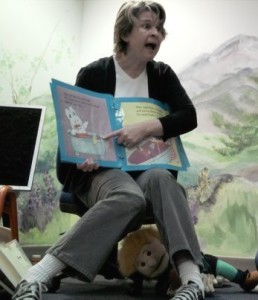Storytime is a different library service than reference work, reader’s advisory, or circulation assistance in that it is not a one-to-one transaction. It is a performance, a show, not a conversation. To present the best storytimes, I believe we need to understand and accept this.
Be Comfortable on Stage
When we’re prepping our storytimes, we need to not just prepare our material, but prepare ourselves to be in front of an audience, and be their center of attention. Their eyes will be on us, their attention will be to our actions, and not only do we have to accept this, but we have to go out of our way to ensure it! This is a very different mindset than we have the rest of our week. (Well, I don’t bust out in song in the produce section, but maybe you do.)
We need to be willing to expand our working definition of professional behavior so that it includes singing, dancing, and expressing ourselves to grownups and children without being self-conscious. Even reading books to a group requires a different skill set than reading to one or two children at home.
Fill the Stage
We can be comfortable on a stage and still not be very practiced at it. This is natural! Not all of us have high school drama or band or choir solo experiences to draw on, or are natural extroverts. But I think successful storytimes do require thought beyond book and material selection, to dramatic conventions such as voice projection, audience awareness, prop manipulation, staging, pacing, and continuity.
When you watch actors on TV or on the stage, it’s easy to get caught up in the story and forget how much rehearsal and attention to detail goes into every show. Actors do breathing exercises to help them project their voices; they do walk-throughs of each scene to learn where they need to stand and how to hold their hands and when and where precisely to pick up and set down props. They practice their lines on their own until they can say them fluidly, then practice them with the rest of the cast to fine tune the timing. Even improv comedians practice! They may not be rehearsing lines, but certainly they work on how to express emotions with their faces and bodies and they build their general background knowledge so they can make connections on stage and they brainstorm possible reactions to different scenarios.
Storytime Providers are Performers
Storytime providers have lines, and sets, and props, as well. Preparing for storytime shouldn’t just mean choosing your books and your songs, but practicing holding your book and singing your song. It means setting your stage so you know exactly where each item is and you can put your hands on it at the right time. Bands prepare set lists and know who is going to introduce each song; storytime providers can too. You don’t have to follow your plan to the letter, but thinking a sequence through in advance and planning some transitional comments can save you time and lessen your distraction during storytime itself. Part of your thinking about storytime is running through possible situations ahead of time—what will you do if no one wants to get up and dance? What will you do if you have a super-chatty three-year-old?
A couple of years ago, I was presenting a “Moon and Rockets” storytime to a crowd of infants and young toddlers. I was sitting in my chair, talking about what astronauts wear, and all of a sudden I looked down and saw my friend Tyler. He was about 8 months old, and had crawled all the way across the room, grabbed the hem of my skirt, and pulled it out over his head. I laughed and said, “Tyler! Astronauts ALSO wear underwear, but we aren’t talking about that today!” Everyone else laughed too, and Tyler’s mom scooped him up, and on we went with storytime.
This is a funny story, and I love to tell it because believe me, I am not always so quick witted and people don’t always laugh at my jokes! But I tell it also because that response is not something I would have been capable of as a newbie storytime provider. It took a lot of practice and a lot of storytimes to get me to the point where I am that comfortable on stage. Where the unexpected doesn’t (usually) disconcert me, where I’m comfortable with all eyes on me (even during slightly embarrassing moments), where I can interact spontaneously with my audience, and where I’m able to keep storytime moving along to the next scene.
Give Yourself Credit
I also think we owe it to ourselves and our profession not to disparage our fill-the-stage performances or our funny improv moments as “just being goofy” or “just being a kid.” You know what? You may be having a great time (in fact that’s another one of my essential elements), but if people are enjoying your storytime, it’s not just by chance. Consciously or unconsciously you are working hard to command the stage, empower yourself, and employ dramatic techniques to enable your audience’s understanding and enjoyment. Don’t brush that off. And if your style is not over-the-top, you are still filling the stage. You don’t have to chew the scenery to embrace the performance. (In fact one storytime provider I know is so Zen and calm I always leave her storytimes feeling like I’ve been to the spa.)
I think that treating storytime as a true performance contributes to a successful storytime. What do you think? Let us know! Then come back next week to find out what else is on my list!



.jpg)

19 Responses to Essential Elements of Storytime: Embracing the Performance